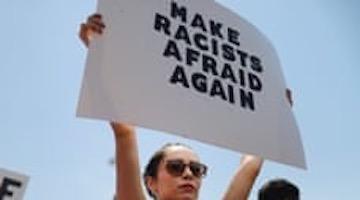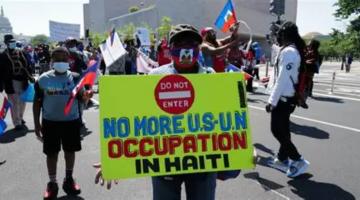The Rebellion Against Police Repression Must Guard Against ALL Enemies, Whether Red, Blue, or Green
The terrain of struggle will need to expand for the movement to avoid a Democratic Party-induced slumber.
“The movement’s enemies in blue not only include the cops but also the entire Democratic Party.”
The masses are in motion and public opinion about U.S. policing has rapidly shifted in three short weeks. George Floyd and Breonna Taylor’s assassination at the hands of U.S. police departments unleased a flood of anger toward the special bodies of armed forces that occupy the streets of Black American communities across the country. New York, Philadelphia, Chicago, Minneapolis, and Washington D.C. have seen tens of thousands of people march several miles per day demanding that police departments be defunded or abolished altogether. Protestors of all hues have been brutalized and journalists have been targeted with flurries of rubber-coated steel bullets and tear gas cannisters. The Trump administration and local politicians, many of them Black, have taken a “law and order” approach to the demonstrations which has further emboldened “local” police forces and their protectors in the National Guard to use any means necessary to crush the protests.
War is an extension of politics. The war currently being waged on Black America and the mass movement against police repression is an extension of a broader political reality that has been in development for several centuries. Settler colonialism and the racialized mass enslavement of African labor looted trillions of dollars of wealth and prematurely ended hundreds of millions of lives. Over the last four decades alone, police departments and prisons have become highly militarized tools for the continued suppression of the Black liberation movement and the disposal of the large number of unemployed and underemployed Black workers who have been rendered unnecessary under late stage capitalism. Late stage capitalism’s reliance on state repression has also eroded the wages of whiteness and compelled once middle-class aspiring white youth and other social groups to reject their state overseers and join the call for an end to policing as we know it.
“The Trump administration and local politicians, many of them Black, have taken a ‘law and order’ approach.”
Movements are defined by their demands, but they are also shaped by the struggle to define the adversaries who must receive and respond to these demands. The masses in the streets have clearly drawn a line of demarcation between the movement and the police, local governance, and the Trump administration. Ruling class organs of all kinds have taken notice and have begun mobilizing to keep themselves out of the line of fire. In early June, corporations such as Amazon and Nike released statements of support to the mass movement. Michael Jordan pledged one hundred million dollars to non-profit organizations participating in the daily demonstrations. NFL commissioner Roger Goodell issued an apology to the movement for its role in minimizing racism. Democratic Party leaders in Congress kneeled in Kente cloth for a photo opportunity before introducing police reform legislation.
The movement has sparked the attention of its enemies; the next step is to define them as such. Rebellions and mass movements become increasingly confident that social change is possible when it appears that politicians are making efforts to address their demands. However, spontaneity also runs the risk of the movement underestimating the scope and power of the enemy class. As movements develop, the need to define the character of the enemy system and its overseers becomes more acute.
On the political front, Donald Trump’s administration is looking more vulnerable by the day. The combination of a failed pandemic response, a crushing economic crisis, and a mass rebellion against police repression has placed Trump’s bid for a second term in peril. Such vulnerability, however, leaves room for the repetition of dangerous, and deadly, political mistakes. There are forces within the non-profit industrial complex and the Democratic Party who are attempting to operate in stealth to divert the movement toward acceptable means of protest. With the November election fast approaching, much of this activity will be geared toward electing a Democrat to the White House.
“Ruling class organs of all kinds have taken notice and have begun mobilizing to keep themselves out of the line of fire.”
So-called progressive pundits have already begun to waver in their criticism of Joe Biden, who clinched his nomination as the Democratic Party’s presidential candidate on June 5th. A narrative is forming that Donald Trump represents a particularly horrific form of “authoritarian” rule for threatening to employ the Insurrection Act of 1807 and send the U.S. military to crush the protests. In the minds of a broad number of Democrats, Biden is a much more palatable alternative to the big orange menace in the White House. U.S. electoral politics have historically relied upon lesser evil debates to maintain the illusion of “democracy.” In the age of Trump, the shrieks from corporate Democrats to support the DNC regardless of its orientation toward workers and oppressed people have only become louder.
It is thus important to deal directly with the contradictions that will surely impact the movement going forward. A major contradiction is that while Joe Biden is arguably the architect of the modern mass incarceration state terrorizing Black Americans, many Black voters willvote for Biden in November and do so without hesitation. Donald Trump and the White Man’s Party remain the most visible existential threat to Black life because a Black-led alternative to the Democratic Party has yet to emerge. Those white progressives and leftists now finding themselves wondering whether they should support Biden to protect what is left of American “democracy” from Trump are learning a key lesson about the state of Black politics in America. Black life in the United States is defined by crisis: a crisis of racist state violence, of economic discrimination and poverty, and of political powerlessness. In the post-Civil Rights era, the duopoly has taken two vastly different approaches toward maintaining this arrangement. Democrats have recruited a Black misleadership class to help push through anti-Black and anti-worker policies while Republicans have adopted a full segregationist political orientation to protect any encroachment on white corporate power.
“A Black-led alternative to the Democratic Party has yet to emerge.”
So far, the mass movement has made inroads in delegitimizing the local rule of corporate Democrats and identifying the cops as the principle enemy of the people. This has effectively forced local officials in Minneapolis and Los Angeles to make gestures toward defunding and “dismantling” their police departments. While these reforms cannot possibly address the full extent of the problem, their very presence is proof of the power of fighting back against the state. Less is known about how the movement will react when the state rolls out the rest of its repressive tools. During the Black uprising that began in 2014 in Ferguson, the state deployed the non-profit industrial complex and a counter insurgency war on “Black Identity Extremists” to disorganize the movement just enough for the 2016 election to finish the job. That the mass reaction to George Floyd’s murder has not been so quick to fade is no coincidence. To paraphrase Fred Hampton, you can kill the revolutionary, but you cannot kill the revolution.
The terrain of struggle will need to expand for the movement to avoid a Democratic Party-induced slumber. This is no time for capitulation or retreat. Joe Biden cannot be allowed to feign support for a movement that he helped create through decades of advocacy for race-based segregation and the New Jim Crow. The movement’s enemies in blue not only include the cops but also the entire Democratic Party. Democratic Party politicians of all iterations have done nothing to curb the crisis conditions facing Black Americans in the United States. In fact, the Congressional Black Caucus is implicated in helping make the cops a protected class and funneling billions in military weaponry to local police departments through the 1033 program.
“This is no time for capitulation or retreat.”
Furthermore, it is unacceptable for any progressive or leftist to support the Democratic party on the grounds that the big orange menace threatened the military on protestors. The Democratic Party has sent the military apparatus to repress and destroy entire nations such as Iraq, Libya, Syria, and Ukraine. Movement activists must ask themselves what makes the people of these nations so different from people in the U.S., especially Black people, fighting for justice here in the mainland of empire. Why is it that American style “democracy” is unquestionably good for Hong Kong but so devastatingly brutal for Black Americans and majorities of working people in the U.S.A.? Without internationalism and solidarity, there can be no operational “left” in the United States.
Democrats are already making moves to placate the mass rebellion against racist policing with the same weapons of psychological warfare that have desensitized most Americans to imperialist warfare abroad. Their overtures toward reforms are meant to make the U.S. “what it could be.” In other words, the Democrats’ entire struggle is based upon the defense of American exceptionalism and to ensure that the essential character of the U.S. as an imperialist destroyer masquerading as a “democracy” remains unchanged. The danger lies in the possibility of even a fraction of the movement becoming satisfied with reforms presented in a society where genuine change is not possible under its current economic and political arrangement. George Floyd’s publicized murder placed American exceptionalism in crisis, but its most impassioned doctrinaires in the Democratic Party will stop at nothing to steer the movement in a direction that protects, rather than dismantles, the rule of the rich.
“Democratic Party politicians of all iterations have done nothing to curb the crisis conditions facing Black Americans in the United States.”
That said, the biggest enemy of the movement worships green: the capitalist class. Police departments do not rule on their own even if they stand above society and possess their own independent set of interests. Police would not exist if there was no private property to protect and a class of people who own that property. The cops, the prisons, and the instruments of war act as a deadly shield for those very same individuals who sit in the board rooms of the major corporations currently making statements in support of the movement. Until this enemy is identified clearly and forced out of its ideological bunkers in the corporate media, the state will continue to murder and oppress Black lives no matter how long the protests persist.
There is no question that the GOP and its leader, Donald Trump, represent an existential threat to humanity. That enemy is clear. The problem that so often occurs within spontaneous uprisings in the neoliberal era is when the clear enemy becomes the only one. The Democrats in blue defend the cops just as much as their Republican counterparts wearing red, albeit in their own way. Both parties are controlled by a capitalist class whose primary reason for existing is green—not green energy or the Green Party but the accumulation of profits at the expense of oppressed and exploited peoples. It is thus essential for the movement to develop an understanding that the cops are not some institution that stands alone but rather one that operates as the violent bodyguard of the biggest enemy of them all: American capitalism.
Danny Haiphong is an activist and journalist in the New York City area. He and Roberto Sirvent are co-authors of the book entitled American Exceptionalism and American Innocence: A People’s History of Fake News--From the Revolutionary War to the War on Terror (Skyhorse Publishing). He can be reached at wakeupriseup1990@gmail.com, on Twitter @spiritofho, and on Youtube at The Left Lens with Danny Haiphong.
COMMENTS?
Please join the conversation on Black Agenda Report's Facebook page at http://facebook.com/blackagendareport
Or, you can comment by emailing us at comments@blackagendareport.com





![Don’t [Mourn] Celebrate, Organize!](/sites/default/files/styles/nc_thumb/public/2020-11/Enteen_360x200.jpeg?itok=N1ROiKEs)













